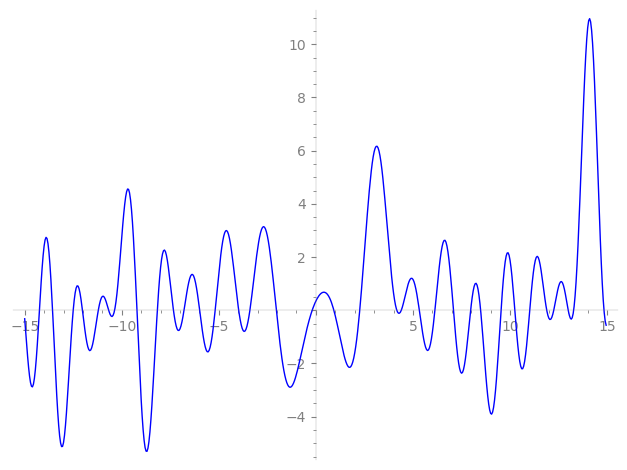| L(s) = 1 | + (−1.72 + 0.124i)3-s + (−1.73 + 3.01i)5-s + (2.96 − 0.431i)9-s + (−1.25 − 2.17i)11-s + (−0.292 + 0.505i)13-s + (2.62 − 5.42i)15-s + 1.09·17-s − 5.93·19-s + (−3.19 + 5.52i)23-s + (−3.55 − 6.15i)25-s + (−5.07 + 1.11i)27-s + (0.918 + 1.59i)29-s + (−3.51 + 6.09i)31-s + (2.44 + 3.60i)33-s − 1.40·37-s + ⋯ |
| L(s) = 1 | + (−0.997 + 0.0721i)3-s + (−0.778 + 1.34i)5-s + (0.989 − 0.143i)9-s + (−0.379 − 0.656i)11-s + (−0.0810 + 0.140i)13-s + (0.678 − 1.40i)15-s + 0.265·17-s − 1.36·19-s + (−0.665 + 1.15i)23-s + (−0.710 − 1.23i)25-s + (−0.976 + 0.214i)27-s + (0.170 + 0.295i)29-s + (−0.631 + 1.09i)31-s + (0.425 + 0.627i)33-s − 0.231·37-s + ⋯ |
Λ(s)=(=(1764s/2ΓC(s)L(s)(0.313+0.949i)Λ(2−s)
Λ(s)=(=(1764s/2ΓC(s+1/2)L(s)(0.313+0.949i)Λ(1−s)
| Degree: |
2 |
| Conductor: |
1764
= 22⋅32⋅72
|
| Sign: |
0.313+0.949i
|
| Analytic conductor: |
14.0856 |
| Root analytic conductor: |
3.75308 |
| Motivic weight: |
1 |
| Rational: |
no |
| Arithmetic: |
yes |
| Character: |
χ1764(589,⋅)
|
| Primitive: |
yes
|
| Self-dual: |
no
|
| Analytic rank: |
0
|
| Selberg data: |
(2, 1764, ( :1/2), 0.313+0.949i)
|
Particular Values
| L(1) |
≈ |
0.3476519064 |
| L(21) |
≈ |
0.3476519064 |
| L(23) |
|
not available |
| L(1) |
|
not available |
L(s)=p∏Fp(p−s)−1 | p | Fp(T) |
|---|
| bad | 2 | 1 |
| 3 | 1+(1.72−0.124i)T |
| 7 | 1 |
| good | 5 | 1+(1.73−3.01i)T+(−2.5−4.33i)T2 |
| 11 | 1+(1.25+2.17i)T+(−5.5+9.52i)T2 |
| 13 | 1+(0.292−0.505i)T+(−6.5−11.2i)T2 |
| 17 | 1−1.09T+17T2 |
| 19 | 1+5.93T+19T2 |
| 23 | 1+(3.19−5.52i)T+(−11.5−19.9i)T2 |
| 29 | 1+(−0.918−1.59i)T+(−14.5+25.1i)T2 |
| 31 | 1+(3.51−6.09i)T+(−15.5−26.8i)T2 |
| 37 | 1+1.40T+37T2 |
| 41 | 1+(−5.37+9.31i)T+(−20.5−35.5i)T2 |
| 43 | 1+(5.67+9.83i)T+(−21.5+37.2i)T2 |
| 47 | 1+(−3.76−6.52i)T+(−23.5+40.7i)T2 |
| 53 | 1−11.6T+53T2 |
| 59 | 1+(−2.22+3.85i)T+(−29.5−51.0i)T2 |
| 61 | 1+(6.17+10.6i)T+(−30.5+52.8i)T2 |
| 67 | 1+(−6.33+10.9i)T+(−33.5−58.0i)T2 |
| 71 | 1+4.93T+71T2 |
| 73 | 1−8.71T+73T2 |
| 79 | 1+(−0.280−0.485i)T+(−39.5+68.4i)T2 |
| 83 | 1+(3.68+6.38i)T+(−41.5+71.8i)T2 |
| 89 | 1−12.1T+89T2 |
| 97 | 1+(6.98+12.0i)T+(−48.5+84.0i)T2 |
| show more | |
| show less | |
L(s)=p∏ j=1∏2(1−αj,pp−s)−1
Imaginary part of the first few zeros on the critical line
−9.217237232050430273013994259126, −8.167135176280835190392007942556, −7.33740177228996824869941513501, −6.79261291213393413620606959807, −5.98722551804189655471573395658, −5.18907297628816534698443414353, −3.97686316805466555623818608643, −3.39991089046578261480340387825, −2.03741848412178840070040362449, −0.19049812709674808531589148802,
0.923916308569710567632737425637, 2.25779341363306444709129470639, 4.16673041092370958248955059272, 4.39830649077907980905875010050, 5.32698404145192458756348121595, 6.12985274750084570377972304229, 7.08650178993723346660949370236, 7.970625843578736775795026261699, 8.484846483616858177209772941595, 9.537280136241147625368058798974

